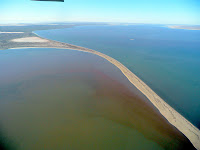 |
The gullies were full of river gums
taken straight from a
Hans Hysen painting |
 |
The lookout at the west of Hawker
gave a panoramic view of the ancient sea-bed |
 |
How lucky can you get...
we saw the rare
'yellow footed rock wallaby' |
We readied ourselves early for our second day of adventure (Wednesday 21st July). Before breakfast we drove to the local look-out 6km out of town with a glorious view over Hawker and the surrounding plain. We were early enough to catch the local kangaroos on the road and raced a couple for 1 km averaging 40 km/hr, before they took to the side trail (we stayed on route to the Lookout). The steep uphill walk to the lookout was a perfect heart-starter for the day.
 |
| Historic sorting yard used by early graziers |
We only had 150 kms to travel to our next accommodation at Leigh Creek… so we had an opportunity to explore the gorges recommended by Mike and Maureen. We headed out towards Wilpena Pound… but took a back road through Arkaba Station and the rolling hills to the west of the Pound - Moralana scenic Drive. The green country was at its best and the colourful ranges made for a picturesque backdrop. The sense of being in the outback was enforced by the enjoyable driving through numerous creek-beds.
 |
| 150 million years of geological history in a 10km track |
This road took us back onto the main Leigh Creek road. However, we took another longer detour to see Brachina Gorge. The area has a dramatic geological history… with the folding that made the Flinders Ranges causing a display of rock with ages from 500 million years ago up to 660 million years ago all visible over a matter of 10 kms of travel. Good signage assisted us to appreciate the changes in geology.
We started with the youngest rocks with Cambrian fauna and flora… lots of fossils. We then went to the Cambrian/Pre-Cambrian divide where we saw worm holes marked in the rocks. Once we got to rocks aged older than 600 million years, we just had the rocks… no fossils. However, the folds in the rock and their colouring were most dramatic. At one spot we hurried to a stop in a tight turn-off to read the next sign. As we read, we saw movement in the bushes above us and out popped a yellow footed rock wallaby… a species that is quite rare. The animal patiently waited while we took our camera shots then hopped up into the rocky hillside. We felt very fortunate. Our track was pretty rough; so we declined the invitations to branch off into more remote gorges. We continued on our way and saw a few emus. One mother had a clutch of 5 chicks.

Next stop was Blinman where we wandered around the old copper mine before driving through yet another picturesque gorge - Parachina Gorge and back onto the main road.
 |
Monument to the early camel train explorers who left from
Beltana Homestead |
We still had plenty of daylight left, so made one last detour for the day. We turned off the main road again towards Beltana, a heritage town (that refuses to die). We accidentally pulled into Beltana Homestead and talked to the lady staff member. She pointed out a monument to the Camel drivers… most of whom [including Ernest Giles in 1875] started their expeditions at Beltana Station. She mentioned the current owner had recently re-consolidated the initial holding to just under 0.5 million acres. A few more kilometers along the road bought us to the old town itself... it looked a sorry sight; not the pioneering village that existed in the day of John Flynn (of flying doctor fame). The road back to the main road was interesting… but did not deliver the excitement of Brachina Gorge, despite seeing lots of evidence of the original Ghan Railway and one dramatic cutting.
Which brings us to the theme of the day… we planned a day of logistics to lay the foundation for fun to follow. What we experienced was one of the best touring days we had ever enjoyed. Our learning from the day… stay flexible… go with the flow… remain open for spontaneous changes in itinerary.
 We needed to have the car back at the airport b y 12:00 noon, so had limited opportunity for extra events. Our visit to Dublin was probably the highlight (we were extremely toured-out by this time). We turned off the A1 highway to take a look at Gawler… a thriving centre on the border between the wheat and wine growing areas. Then we made our way to the airport… and here we are… exhausted…. elated… and looking forward to our next holiday.
We needed to have the car back at the airport b y 12:00 noon, so had limited opportunity for extra events. Our visit to Dublin was probably the highlight (we were extremely toured-out by this time). We turned off the A1 highway to take a look at Gawler… a thriving centre on the border between the wheat and wine growing areas. Then we made our way to the airport… and here we are… exhausted…. elated… and looking forward to our next holiday. 








































